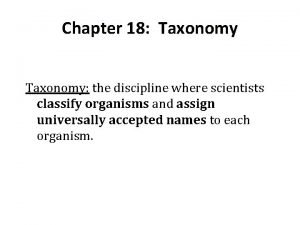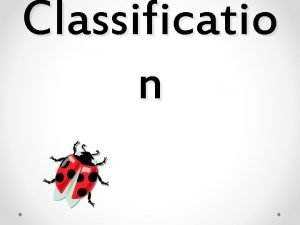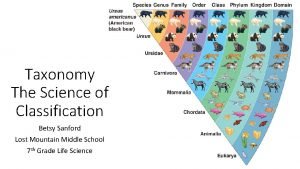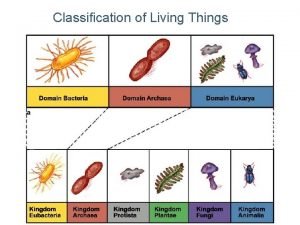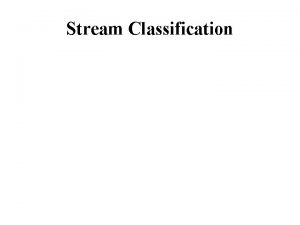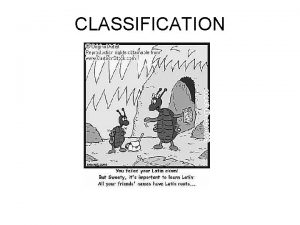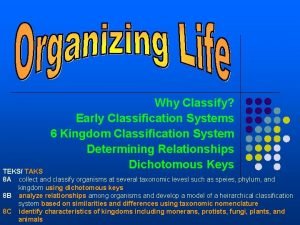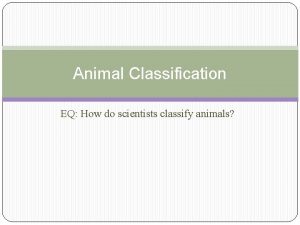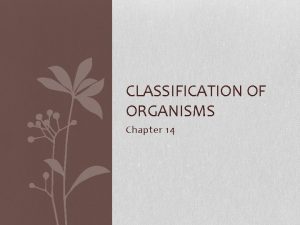CLASSIFICATION KINGDOMS Why do scientists need to classify





















- Slides: 21

CLASSIFICATION & KINGDOMS

Why do scientists need to classify organisms?

Classification • For thousands of years scientist and naturalists have attempted to understand the relationship between organisms.

Classification 1. Over 2000 years ago the Greek philosopher Aristotle began grouping plants and animals according their structure.

Classification 2. Taxonomy The science of naming and categorizing organisms.

Classification 3. In the 1750’s a Swedish Biologist named Carolus Linnaeus devised a Latin two-word system called binomial nomenclature.

Classification Canis lupus Genus - First word refers to a taxonomic category containing similar species. Organisms are assigned to a genus based on major characteristics. Canis latrans

Classification The 2 nd word identifies a particular organism within the genus and is typically a descriptive word. • canis lupus – lupus is Latin for wolf

Classification • This two word system is the accepted scientific method of naming organisms world wide.

Classification • 1. Prokaryote • 2. Eukaryote • 3. Heterotrophy • 4. Autotrophic • 5. Unicellular • 6. Multicellular • 7. Classification • 8. Taxonomy • 9. Linnaeus • 10. Binomial Nomenclature

Taxonomic categories: • BROADEST TO MOST SPECIFIC • Kingdom……King • Phylum……. . Philip • Class………. Came • Order………. Over • Family……. . . For • Genus………Good • Species……. Soup


Taxonomic categories: • Kingdom – A group of closely related phylum. • Animalia

Taxonomic categories: • Phylum – A group of closely related classes. -Chordata

Taxonomic categories: • Class – A group of closely related orders. -Mammalia

Taxonomic categories: • Order – group of closely related families -Carnivora (meat eater)

Taxonomic categories: • Family – group of closely related genus • Felidia (cats)

Taxonomic categories: • Genus – group of similar species that are alike in general features and are closely related. -Panthera

Taxonomic categories: • Species – Physically & genetically similar and able to successfully reproduce. -Panthera tigris (Bengal Tiger)

Domains to Kingdoms There are three domains: Eukarya Archaea, Bacteria,

6 Kingdoms • Archaebacteria – Domain Archaea • Eubacteria – Domain Bacteria • Fungi – Domain Eukarya • Protists – Domain Eukarya • Plants – Domain Eukarya • Animals – Domain Eukarya
 The scientific discipline of classifying organisms
The scientific discipline of classifying organisms Why do scientists classify organisms?
Why do scientists classify organisms? How do scientists classify stars?
How do scientists classify stars? How do we classify stars
How do we classify stars F
F How do scientists classify organisms
How do scientists classify organisms How do scientists classify protists
How do scientists classify protists Hey hey bye bye
Hey hey bye bye Rules for significant figures
Rules for significant figures First layer of the earth
First layer of the earth What are the 3 domains and 6 kingdoms of classification
What are the 3 domains and 6 kingdoms of classification What are the 3 domains and 6 kingdoms of classification
What are the 3 domains and 6 kingdoms of classification Six kingdom
Six kingdom Domains kingdoms and classification 14-15 answer key
Domains kingdoms and classification 14-15 answer key Why are protists the junk drawer
Why are protists the junk drawer Dont ask
Dont ask Why do we classify living things
Why do we classify living things Why isn't it a good idea to classify matter by its phases
Why isn't it a good idea to classify matter by its phases Why do biologists classify
Why do biologists classify Why architects need to use their ears
Why architects need to use their ears Shakespeare richard ii quotes
Shakespeare richard ii quotes Three living organisms
Three living organisms
